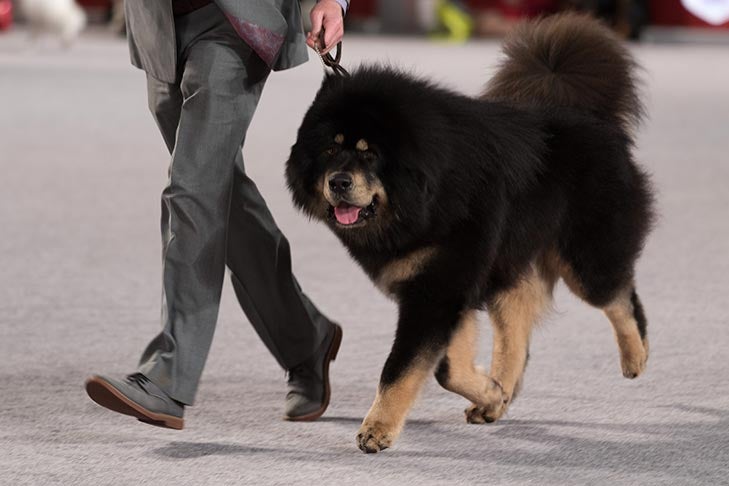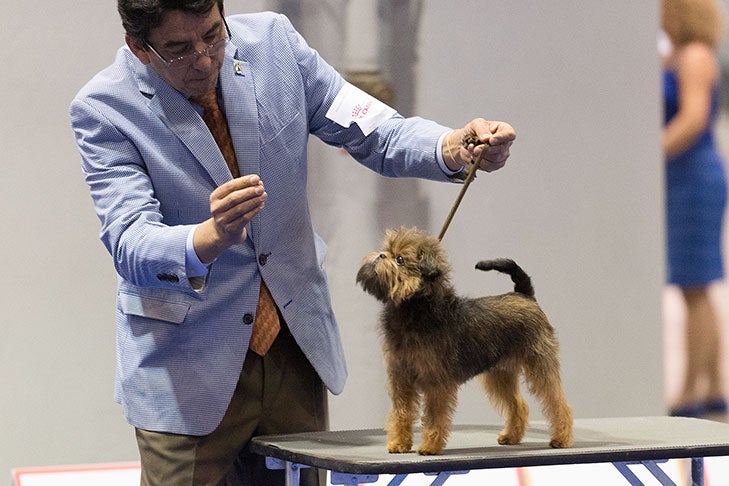If you’ve never been to a dog show, get ready for a culture shock. These gatherings of the dog-obsessed started in the 19th century, and much of the terminology from long ago still persists today. Some of the verbiage also evolved from the idiosyncrasies of this close-knit community, where the endless focus is purebred dogs and how to present them at their best.
To get up to speed, skim this beginners’ guide to dog-show lingo. With a few phrases under your belt, you’ll be fitting in in no time.
Bait
Most dogs don’t work for free, so the use of food to motivate them in the ring is a common occurrence. “Bait” is any edible item used to animate a dog. While cooked liver is the gold standard, anything that drives a dog wild – from roast chicken to pieces of bagel – is fair game. Watching where exhibitors hide their bait always makes for an amusing pastime. Morsels have been known to emerge surreptitiously from brassieres and even exhibitors’ own mouths.
Benched Dog Show
Once upon a time, all dog shows were benched. Owners were required to have their dogs displayed on partitioned wooden stands, or benches, where the public could see and admire them. This wasn’t just an educational experience for spectators, but for dog-show folk as well.
Forced to stay at the show all day long, they shared conversations and information with their fellow competitors, gaining knowledge often by osmosis. But as modern life became more harried, and lifestyles more frenetic, benched shows became the exception rather than the rule. Today, only a handful of benched shows survive, the most famous of which is New York City’s Westminster Kennel Club Dog Show.

Best
Short for “Best in Show,” as in “Do you know what time they’re doing Best?” Best in Show is the ultimate competition at day’s end, between the winners of the seven AKC groups. In 2012, the AKC introduced “Reserve Best in Show,” which is essentially a runner-up to Best in Show. This is awarded before Best in Show, so as not to be anticlimactic.
Bitch
Long before “the B-word” became a borderline obscenity, it had a very straightforward meaning: a female dog. Drawing on the mores and language of bygone centuries, the dog sport uses this term freely and without self-consciousness. And since female dogs are called into competition that way (“Bitches numbers 4 and 16 in the ring, please!”), prepare to hear it often.
Breed Standard
Every breed, from the Alaskan Malamute to the Yorkshire Terrier, has a written document that describes exactly what an ideal specimen looks like, from the tip of its nose to the end of its tail, as well as how it should move and behave. Dog-show judges base their decisions on how well each dog meets the breed’s standard.

Class Animals
Status-wise, there are two kinds of dogs at dog shows – those that are champions, and those that would like to be. Non-champions compete in the hopes of earning some of the 15 points required to complete their championships. They are referred to as “class” dogs and bitches because they are divided into various classes depending on their age or other criteria. Taken as a whole, the competitive field vying for these championship points is referred to as “the classes.”
Conformation
Be sure to spell this right. Confirmation is what you get when the cable guy calls to say he is on his way. Conformation is the judging of purebred dogs based on how they “conform” to the standard for their breed.
Dog
Yes, we know, every entry at a dog show fits this description. But dipping back into our somewhat archaic lexicon, a “dog” at a dog show refers to the male of the species. Females are bitches; males are dogs.
DQ
Shorthand for “disqualification,” which is a trait that, if present, immediately eliminates a dog from competition. Some DQs apply to all dogs – such as the absence of two normally descended testicles in males. But others are specifically mentioned in a breed’s standard, such as blue eyes in a Samoyed.
Ex
Short for “exercise.” Often used as a verb, as in “I’m going to ex my dog,” which is common vernacular for pottying your dog. Portable, often metal enclosures known as “ex-pens” are usually set up outside an exhibitor’s RV, car, or other convenient outdoor space for these purposes.
Gait
Used as a noun, this refers to a dog’s movement, which in the show ring is almost always a trot. It can also be used as a verb, as in “gaiting my dog.” Dog show people never, ever say “prance.”

Groups
Dog shows are structured like a pyramid. At the base is the breed competition, where dogs vie against members of their own breed to win Best of Breed. At the very top, there is room for just one Best in Show dog. Sandwiched in between are the group competitions, where the Best of Breed winners from each breed compete in their respective groups. The AKC has seven groups – Sporting, Hound, Working, Terrier, Toy, Non-Sporting, and Herding – which are sorted based on function and history. The seven group winners are the final competitors for Best in Show.
Major
For class dogs, all wins at a dog show are not equal. The number of dogs in competition dictates how many points a win will carry, up to a maximum of five. Becoming a champion means earning 15 points, but this can’t be accomplished with 15 single-point wins. Instead, two of the wins must be “majors,” meaning they have a value of three, four, or five points.
Special
A noun used for a champion that an exhibitor is showing, typically as part of an organized, sustained “campaign” to break into and maintain a national ranking.
Stack
The term for the static pose a dog holds when the judge is watching. A “free stack” refers to a dog posing itself all on its own, without the help of its handler.

Super
Short for superintendent, which is the organization that runs the event for the show-giving club. The superintendent provides armbands, judges’ books, catalogs, and ring gates. Stowed under their tent or booth is other equipment, like wickets and scales for those breeds that have disqualifications for height and weight (such as Whippets and French Bulldogs, respectively).
Winners
The non-champions who earn championship points at each dog show are called the “Winners Dog” and “Winners Bitch,” respectively. The judge also chooses a runner-up in each sex, called the “Reserve Winners Dog” and “Reserve Winners Bitch.” These would be the winners in the case where one of the Winner’s points are found ineligible for some reason.
The AKC National Championship is right around the corner, and you don’t want to miss the action! Tune in to ABC on December 31 at 2 p.m. ET to see who’s crowned Best in Show.
Did you miss last year’s show? You can watch the 2022 AKC National Championship Presented by Royal Canin on demand on AKC.tv!

